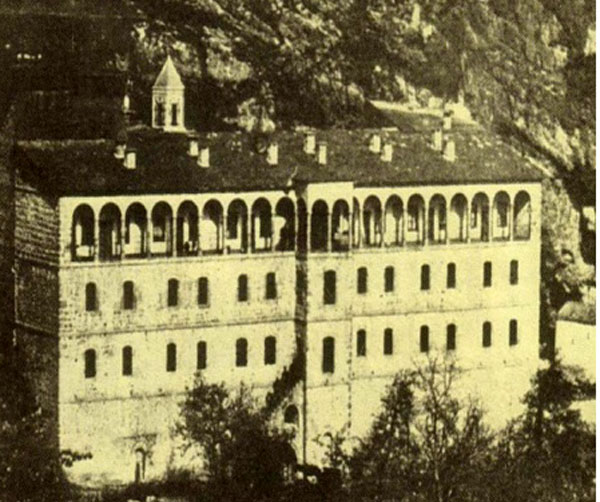Sam Topalidis 2021
Like all major Pontic Greek monasteries, Vazelon is based on a sacred cave. It was supposedly founded around 270 AD and was then supposedly rebuilt after a 6th century Persian invasion. The monastery of John, the worthy Forerunner and Baptist, at Vazelon on Mt Zaboulon, in Machka was, with Soumela and Peristereota, one of the three great Trabzon monasteries which dominated the cultural, social and economic life of Machka from the 13th to 20th centuries. In the Matzouka Valley, below Vazelon, there are impressive records of the cultivation of the same fields by the same families for up to six centuries. In 1890, Vazelon possessed 20 villages (Bryer 1970; Bryer and Winfield 1985).
The Vazelon monastery is located 45 kilometres south-west of Trabzon in north-east Anatolia and 15 kilometres south-west of Machka at a height of around 1,210 metres. A monastery was built next to the chapel and a part of it remained in the rock face. It was enlarged at the front which gave rise to its present shape which is about 40 metres long (Plate 1). The walls of the monastery were made of cut andesite. The main development of the monastery was made by the Komnenoi emperors of Trebizond in the 13th century and they exempted the monastery from taxation. Immediately after the Ottoman Turk conquest of Trabzon in 1461, the monastery escaped physically damage (Çavuş 2016).
In 1719, the monastery was looted by robbers who stripped its rich archive <https://epontos.blogspot.com/2010/10/blog-post_2403.html>.
In April 1916, Turkish gendarmes and soldiers surrounded the monastery. They ordered all the monks and around 800 people to abandon the monastery and be moved south to Gumushane. Five monks and about 300 Christians escaped (momentarily) and hid in the neighbouring wood. The next day, the remainder were taken to the interior (Greek Patriarchate 1919). All the fathers of the monastery, with the exception of abbot Yervasios and hieromonk Nicodemos, escaped (Fotiadis 2019).
When the Russians occupied the Trabzon area (1916 to early 1918), the Russian Professor, Uspenskii, studied the Acts of Vazelon from the monastery and most probably removed them to Russia.
These Acts are a major reservoir of the documentary material concerning Byzantine Pontos. They are a collection of copies of original charters substantiating the monastery’s rights to its lands. It seems that only two manuscripts of the Vazelon codex have survived. One is in the St Petersburg Public Library and comprises 190 documents dating from 1245 to 1704. The other codex is now in the Library of Türk Tarih Kurumu in Ankara. It was copied at the end of the 18th century and comprises 118 documents dating from 1257 to 1818. A critical edition of the St Petersburg codex was published by Uspensky and Beneshevich in 1927, however, it is far from perfect (Shukurov 2011, p. 168).
The last monk at Vazelon, Amarantidis, transported the icon of St John Prodomos to the Aghia Triada monastery in Serres, Greece (Köse and Demciuc 2014). In 1923, after the population exchange, when Christian Greeks were forced to leave Turkish territory for Greece, the monastery was abandoned. It was then destroyed by Turkish treasure hunters. Its roof has fallen in and the front part of the fourth storey at the side of the cave has also collapsed. Today, what is left is [so-called] protected (Çavuş 2016). It remains in urgent need of repair.

References
Bryer, A 1970, ‘The Tourkokratia in the Pontos: some problems and preliminary conclusions’, Neo-Hellenika, vol. 1, pp. 30–54.
Bryer, A & Winfield, D 1985, The Byzantine monuments and topography of the Pontos, vol. I, Dumbarton Oaks Research Library & Collection, Harvard University, Washington DC.
Çavuş, A 2016, ‘A lesser known important cultural heritage source and religious tourism value in Turkey: Vazelon (Zavulon) monastery’, International Journal of Humanities and Social Science, vol. 6, no. 1, pp. 190–99.
Fotiadis, KE, 2019, The genocide of the Pontian Greeks [translator not stated], KE Fotiadis, [place of publication not stated].
Greek Patriarchate, 1919, Persecution of the Greeks in Turkey 1914–1918, (Greek Patriarchate in Constantinople), Hesperia Press, London.
Köse, I & Demciuc, VM 2014, ‘Vazelon (St John) monastery of Maçka Trebizond’, Codrul Cosminului, vol. xx, no. 1, pp. 259–72.
Shukurov, R 2011, ‘The oriental margins of the Byzantine world: a prosopographical perspective’, in J Herrin & G Saint-Guillain (eds) 2011, Identities and allegiances in the eastern Mediterranean after 1204, Ashgate, Farnham, Surrey, England, pp. 167–96.


Takipteyim kaliteli ve güzel bir içerik olmuş dostum.